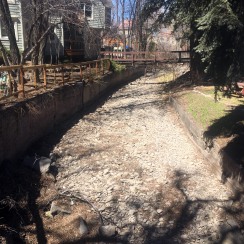For his entire adult life, my grandfather, Herb Billings, was a farmer in the Animas Valley north of Durango, Colorado. He knew when it was time to put out the tomatoes he had started indoors not by looking at the calendar, but by keeping an eye each spring on a particular northerly facing slope of a nearby mountain. When the snow was all melted from the slope, the threat of a killing freeze had passed, meaning the tomatoes would be safe outdoors. During his lifetime, the last patches of snow typically vanished in late May or early June. This year, it was all gone by the end of March.

It was just one of the startling signs of extreme dryness that confronted me when I returned to my hometown a few days ago. The Animas River looks less like the life-taking river of yore than a mild and clear mountain stream that one could easily wade across. During the last few days of March, the flow never exceeded 114 cubic feet per second, a record low (the historical March mean is 308 cfs, and even during the notoriously dry 2002, the March mean was 146 cfs). Junction Creek’s flow is exactly zero. And it’s not because it’s too cold for the snow to melt, as temperatures have been hitting the 70s in recent days.

There’s little relief in sight. On Molas Pass, at 10,900 feet, there is still enough snow for snowmobiling, but only barely. Skiers are still making turns around the slightly higher Red Mountain Pass, but in May-like conditions. And April 1 is typically when the snowpack reaches its peak. If all the visual signs weren’t enough, the snowpack graphs drive the point home: 2018 is shaping up to be the Four Corners Country’s driest water year of the last four decades, perhaps even worse than 2002.
And 2002 was the summer of Southwestern Colorado’s dryland discontent. The Animas River had no spring runoff to speak of that year, with daily flows never exceeding 800 cfs (the historical mean is 2,770 cfs for June). Rafting season was a bottom-scraping bust. Regional reservoirs shrunk; some have never quite recovered. And in early June, a fire broke out on Missionary Ridge above the Animas Valley and scorched 71,000 acres, cost $40 million to fight and killed one firefighter, along with dealing a massive blow to the region’s ever-important tourism economy.

All hope is not lost. The Molas Lake SNOTEL station is registering more snow this year than at this time in 2002. And one of the things that made 2002 so bad was a terribly dry, warm April. There’s always the chance that the weather patterns will radically shift, and this April and May will be cool and wet, staving off a repeat — or worse — of 2002. But don’t count on it. Oh, and one other thing: It’s probably not safe to put the tomatoes out yet.





BUY MY BOOK: River of Lost Souls: The Science, Politics, and Greed Behind the Gold King Mine Disaster (which is about a heck of a lot more than just one mine disaster. It’s a natural and cultural history of the Four Corners Country, too).


